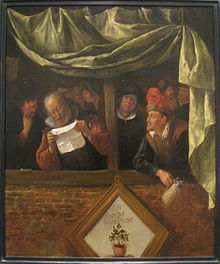- Chamber of rhetoric
-
The Rhetoricians, circa 1655, by Jan Steen. The painting depicts a rederijker reading his poem, while hanging over the balcony the blason of his chamber of rhetoric can be seen; in this case the Amsterdam society "Egelantier", whose symbol was a wild rose (egelantier) and whose motto was "In Liefde Bloeiend".

Chambers of rhetoric (Dutch: rederijkerskamers) were dramatic societies in the Low Countries. Their members are called Rederijkers (singular - Rederijker), from the french word 'rhétoricien', and during the 15th and 16th centuries were mainly interested in dramas and lyrics. These societies were closely connected with local civic leaders and their public plays were a form of early public relations for the city.[1]
History
The first chambers of rhetoric were founded in Flanders around the 15th century; they later flowered in Holland, where they were an important part of the literary scene in the Dutch Golden Age and experimented with poetic form and structure. Most Dutch cities sponsored a chamber of rhetoric, and many cities had more than one, which competed with each other during prize contests. The building that currently houses the Frans Hals Museum was built with the proceeds of a lottery in which chambers of rhetoric participated from all over the country. The Haarlem society Trou moet Blycken still has many of the blazoens that it kept as host of that lottery.
At the start of the 16th century, Antwerp had three rederijker societies, the "Violieren", the "Olijftak", and the "Goudbloem", while Brussels and Ghent each had four rederijker societies.[1] A notable similar fraternity that began in the 17th century was the Guild of Romanists in Antwerp, of which many leading artists were members. This fraternity was not
An important chamber of rhetoric in the Netherlands was "De Egelantier" in Amsterdam: Coster, Bredero, Hooft and Roemer Visscher were all members of this society. During the Protestant Reformation the society sided with the reformers against the city government and enjoyed its most blooming period despite receiving very little funding from official sources.[1]
Because many of the rederijkers were by definition amateurs,[2] the literary quality of their work was often rather low, and in the 18th century, some chambers of rhetoric were spoken of with contempt.[citation needed] Some of their successful works that came from the Rederijkers included: The play Elckerlijc.
See also
References
- ^ a b c Reformers on stage: popular drama and religious propaganda in the low countries by Gary Waite on Google books
- ^ Since most rederijkers were leading men in the city council in the 16th and 17th centuries, they did not make a living from their writing, but earned income through rents and privileges
- De rederijkers en hun invloed op het Nederlands (Dutch)
- Meijer, Reinder. Literature of the Low Countries: A Short History of Dutch Literature in the Netherlands and Belgium. New York: Twayne Publishers, Inc., 1971, pp. 55-57, 62.
- Van Bruaene, A.L., Repertorium van de Rederijkerskamers in de Zuidelijke Nederlanden (Dutch) Overview of the Chambers of Rhetoric in the Southern Netherlands
Categories:- European literature
- Dutch literature
- Literary societies
- Arts in the Netherlands
- Literature stubs
- Belgium stubs
- Netherlands stubs
Wikimedia Foundation. 2010.

